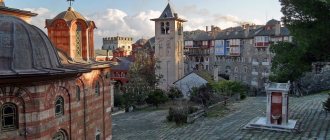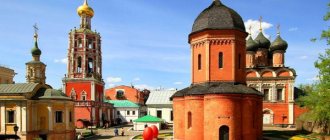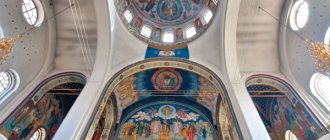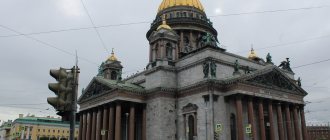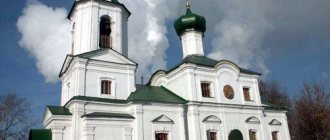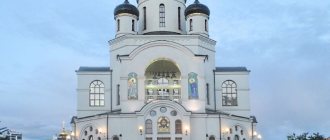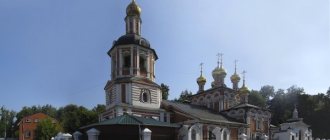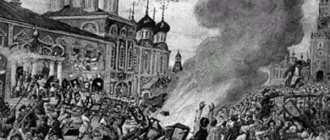The Alekseevo-Akatov Monastery was built on Akatova Polyana and named after Metropolitan Alexy, the miracle worker of Moscow and all Russia. From its foundation in 1620 to 1931, the Alekseevo-Akatov Monastery in Voronezh was a monastery for 311 years. Since 1990, it has been an active convent.
In 2021, the Alekseevo-Akatov Monastery will turn 400 years old, and the city of Voronezh itself will celebrate its 434th anniversary. Akatov Monastery is one of the oldest monasteries in Voronezh. On its territory there is a unique historical object - a bell tower. This is the oldest building that has survived to this day in Voronezh.
Alekseevo-Vladimir Cathedral and bell tower in the Alekseevo-Akatovo convent.
Over the course of its history, the monastery has repeatedly changed its appearance and purpose, destroyed, rebuilt, and restored. The monastery is located on the right bank of Voronezh in the historical center of the city. A beautiful view of the monastery ensemble opens from the observation deck of the Chernavsky Bridge dam or from a pleasure boat on the Voronezh Reservoir.
Story
The foundation of the monastery took place in 1620. The construction was a kind of gratitude from the city residents for the victory in the battle with Cherkassy and Lithuanians. At the beginning, the brotherhood of the monastery (together with the abbot) consisted of 7 people. Over time, the number of novices increased, and the number of buildings also increased.
Theodosius (abbot of the Assumption Monastery), at the request of Abbot Kirill, who served in the Alekseevo-Akatovo monastery, gave part of the land into the possession of the new brethren. Theodosius himself, with several other novices, moved into the walls of the recently built monastery.
In 1630, another temple was located in the monastery's possession - the Mother of God of Vladimir. A limit was established within its walls, named after the patron of the monastery.
From the day of its foundation, the monastery’s possessions included the village of Rozhka (today Otrozhka), located across the Voronezh River. In 1634, the possessions expanded: the villages of Mamon Verkhniy and Nizhny were included here. From 1629 the territory began to be populated by peasants. Initially, in the vicinity of the villages there were only 4 courtyards. In 1676 their number increased to 45.
By royal decree of Peter 1 in 1700, in order to free the territory for state needs, the Monastery of the Assumption was annexed to Alekseevo-Akatovo. In 1742, the management of the monastery rested on the shoulders of the Ostrogozhskys (vicar bishops). Since 1796, the abbot served as rector of the theological seminary at the monastery.
Catherine 2 in 1764 took away the monastery estates to replenish the state treasury. Some monasteries reserved the right to receive salaries, the size of which depended on the class awarded to the shrine. On the territory of Voronezh, only the maiden Pokrovsky and Alekseevo-Akatov monasteries were awarded this honor.
In 1784-1812, a church made of stone, 2 floors high, was built. In 1812, the lower church (the icon of the Mother of God of Vladimir) was consecrated, in 1819 – the upper one (St. Alexei). Services are still held within the walls of the church today.
At the end of the 19th century (1879-1880), a bell tower consisting of 4 tiers was erected in the northwestern part of the monastery. With the advent of Soviet power, the new bell tower was destroyed, and the old structure returned to use.
During the period of active closure of Orthodox churches on the territory of the state (20s of the 20th century), it was the Alekseevo-Akatov Monastery that became the center of the spiritual revival of Voronezh. Divine services, meetings of the Orthodox clergy were held here, and a school functioned.
The monastery was closed in 1931. The lower floors of the main church served as a garage. At various times, artistic workshops, food warehouses, living quarters and even stables were located here.
The bell tower (as an ancient historical monument) was taken under protection in the late 70s. In 1986, restoration work was carried out on its territory. After 3 years (1989), all the buildings of the monastery were transferred to the ownership of the Voronezh diocese.
In the spring of 1990, restoration work began within the walls of the monastery. The restoration was carried out using photographs and old drawings, since the building was virtually completely destroyed by vandals. In June 1990, Patriarch His Holiness Alexei 2 blessed the opening of the Alekseevo-Akatovo women's monastery. The first service within the walls of the renovated monastery took place in the fall of the same year.
In January 1992, the first 10 sisters of the monastery were tonsured at the monastery. Among them was nun Varvara, who became abbess in April 1993. In 1999, the Church of the Presentation, located nearby, was transferred to the monastery.
origin of name
The monastery is named after the first Orthodox saint of the Russian land - Alexei. The day of the memorable battle and victory over the tribes, in honor of which the monastery was built, was also the day of memory of St. Alexei.
The construction of the monastery began on Akatova Polyana (a wooded, uninhabited area two miles from the city). This is where the name of the monastery came from: Alekseevo-Akatov.
Abbots
- Kirill (1621 - 1632)
- Feodosius (Protopopov) [4] (1632 - ?) at the same time abbot of the Voronezh Assumption Monastery
- Ephraim I (mentioned 1647) [5]
- Paul I (mentioned 1651)
- And she
- Joseph I (Varyainov) (mentioned 1653 - mentioned 1666) [4]
- Cornelius (mentioned 1673 - mentioned 1676)
- Pitirim (mentioned 1678 - mentioned 1680)
- Joseph II (mentioned 1686 - mentioned 1688)
- Paul II (mentioned 1690 - mentioned 1698)
- Nicanor (1702 - 1706) [6]
- Joasaph (mentioned 1712) [7]
- Ephraim II, in schema Eugene (1744 - 1749)
- Sampson (1750 - 1762)
- Gervasy (Lintsevsky) (1764 - ca. March 24, 1768)
- Sampson, 2nd time (c. 1767 - 1793)
- Ambrose (Kelembet) (March 22, 1793 - December 29, 1796)
- Justin (Tripolsky) (June 22, 1797 - 1807)
- Afanasy (Savinsky) (1807 - December 22, 1811) [8]
- Samuil (Steblovsky) (December 1811 - February 1812) acting
1841 - 1853 - see bishops of Ostrogozh
- Hilarion (Bogolyubov) (May 27, 1854 - January 12, 1861) archimandrite. [10]
- Feodosius (Shapovalenko) (January 12, 1861 - August 28, 1863)
- Feodosius (Makarevsky) (August 28, 1863 - January 28, 1867)
1867 - 1923 - see bishops of Ostrogozh
- Sschmch. Tikhon (Krechkov) (1924 - January 30, 1930)
- Prmch. Innocent (Beda) (second half of January 1926 [11] - December 17, 1926 [12])
1931 - 1990 - the monastery was abolished and ruined
- Love (Yakushkina) (1990 - April 15, 1992)
- Varvara (Sazhneva) (from April 15, 1992)
Monastery Cemetery
There is a cemetery in the southern part of the churchyard. In the old days, monks of the monastery and noble nobles were buried here. In 1772, a ban on burials near parish churches came into force. Because of this, the cemetery of the Alekseevo-Akatovo Monastery began to grow rapidly.
The governor of Voronezh (winter 1773) is buried on the territory of the cemetery, as evidenced by the inscription on the monument. In 1784, the funeral of Father Palladius, a teacher at the monastery seminary, took place.
Use of the cemetery continued into the 19th and 20th centuries. Tulinov (leader of the province), Labzin (zemstvo secretary), Tsvet (scientist) and others found eternal peace here. As part of the anti-church policy, the cemetery was demolished by the Soviet authorities. In the early 90s, a symbolic necropolis was created on the territory of the destroyed shrine.
Revolutionary time
After the revolution, the temple was destroyed and all the jewelry was confiscated. In the 20s, another abbot was replaced by a jealous opponent of the renovationist movement, Peter (Zverev), and at the same time, Archimandrite Innocent (Beda), sent from Moscow, appeared in the monastery.
The Alekseevo-Akatov Monastery of Voronezh was not closed, like many others, and therefore the center of the spiritual life of the city is concentrated in it.
In 1926, the rector and archimandrite were detained by representatives of the new government and sent to the Solovetsky camp. There they rested with the Lord. The next rector, Bishop Alexy (Buya), was accused of organizing underground anti-Soviet agitation; he served a considerable amount of time in camps and was shot in 1937. In the 1930s, mass arrests of another 75 monks took place. All of them were canonized as saints in 2000 as Russian new martyrs.
Shrines of the monastery
- One of the largest shrines of the monastery is the “Life-Giving Spring”.
The icon depicts the Mother of God emerging from the water. Mary holds the Child in her arms. The shrine has been within the walls of the monastery since 1991. In September 1992, on the eve of the Feast of the Presentation of the Vladimir Most Holy Theotokos, the icon began to stream myrrh.
- Within the walls of the monastery there is an icon of Tambov Pitirim, created at the beginning of the 20th century.
It was given to the temple on the day of its opening by the rector of the village church as a gift. Due to inappropriate storage conditions, the image on the icon was practically indistinguishable. In the evening of 1997, after the evening liturgy, the rector of the temple noticed that the image had brightened and the inscription had become readable. The next day, during the service, the icon began to stream myrrh.
- In the monastery, another miraculous icon exudes myrrh. This is an image of Saints Mitrofan of Voronezh and Tikhon of Zadonsk. In 2002, the icon was restored, after which the shrine began to flow myrrh.
- In the Alekseevo-Akatovo Monastery there is a copy of the icon of the miraculous Athos, St. Andrew's Russian Skete, called “Consolation in Sorrows and Sorrows.”
In the summer of 1999, the icon began to stream myrrh, releasing images of myrrh from the eyes in a stream. Later, the icon also released myrrh for some time, but with less abundance.
In the monastery there are icons with small particles of the relics of the holy martyr Peter Zverev, Confessor of the Venerable Chariton. In 2000, Peter Zverev was canonized. In February 2004, the icon with his image, as well as particles of his relics, was transported to the walls of the convent.
Temples on the territory of the monastery
The main temple is the Alekseevo-Vladimir Cathedral. This temple has been rebuilt many times since its founding in 1674. Only the tented bell tower, originally built, still exists. The historical name of the cathedral is Alekseevo-Voskresensky. Now the lower floor of the temple is consecrated in honor of the icon of the Mother of God, and the upper tier in the name of Saint Alexis of Moscow.
In the courtyard of the monastery there is the Sergius Church, where liturgies are held on Sundays. Services in this church were resumed in 2015.
In the courtyard of the monastery there is a nursing and refectory building, a bell tower, and a water-blessed chapel. The monastery courtyard is very beautiful, especially in spring when the lilac bushes are in bloom. The paths are paved with stone, it is convenient and comfortable to walk around the monastery courtyard, enjoying the views and fresh air, and if necessary, you can sit on benches and relax.
Video: Compound of the Aleksevo-Akatov Monastery
Patronal holidays
Alekseevo-Akatov Convent honors the following patronal feast days:
- February 25 – death of Saint Alexei of Moscow;
- June 2 – discovery and transfer of the relics of Saint Alexei;
- June 3 – icon of the Mother of God of Vladimir (in memory of the salvation of the city of Moscow during the Khan’s invasion of 1521);
- July 6 – icon of the Mother of God of Vladimir (in memory of the salvation of the city of Moscow during the Khan’s invasion of 1480);
- September 8 – Presentation of the icon of the Mother of God (salvation during the invasion of 1395);
- October 18 – Moscow Council of Saints: Alexy, Hermogenes, Jonah, Philip, Peter;
- August 12 – Voronezh Confessors and New Martyrs.
History of the temple during the Soviet years
In the winter of 1930, according to the requirements of the Alekseevo-Akatov plant, the monastery was closed, the ringing of bells was prohibited, and the bells were melted down. And then in 1931 all the monks were kicked out and the icons were burned. Only the miraculous icon of the Mother of God, called the “Life-Giving Spring,” which was kept in the main Intercession Cathedral of Voronezh, survived. She was returned to the monastery with the blessing of Bishop Mythodius only in April 1991. The icon of the Mother of God “Three-Handed” was irretrievably lost.
The Great Patriotic War began, and during the occupation of the city, the gate bell tower was destroyed. In 1943, the entire monastery courtyard was developed for housing. The bell towers contained stables and warehouses. Already in the 60s, the monastery was used by artists, setting up their workshops in it.
In 1970 there was a local history museum here. The Treasury building was destroyed. The wooden building - the abbot's house on the second floor - was given to the needs of the collective farm, and then completely dismantled.
Schedule of services
Divine services within the walls of the Alekseevo-Akatovo convent are held daily.
- On weekdays and Saturdays, liturgies are celebrated 3 times: morning (07:30) and 2 evenings (16:00 and 17:00).
- On Sunday there are 2 services in the morning: early (06:30) and late (08:30) liturgies. Evening services on Sunday are no different from those held on weekdays.
For major religious and patronal holidays, a separate schedule of services is drawn up. Liturgy hours may change, so the holiday schedule must be found out in advance.
Alekseevo-Akatov Monastery (Voronezh). Icons
On September 7, 1997, on the feast of the Presentation, the Sretenskaya Vladimir Icon of the Mother of God began to flow myrrh. The blessed ointment comes out from the scroll of the Infant Jesus and the Rod of the Mother of God.
The icon of the Great Martyr Panteleimon the Healer is miraculous and healing; it also began to exude myrrh in 1997. And at the same time, the icon of St. Pitirim of Tambov, which was painted at the beginning of the 20th century and transferred from the rural parish church to the Aleksevo-Akatov Monastery on the long-awaited day of the opening of the monastery, was renewed. Since the icon was old and was stored inappropriately, the letters on it turned gray and were practically unreadable. But one evening after the service, the image brightened, the background acquired a blue tint, and the letters became golden. During the morning Liturgy, the image began to stream myrrh.
How to get to the convent in Voronezh
There are several ways to get to the Alekseevo-Akatovo women's monastery. From the center you can walk to the embankment, and you will see the construction of the shrine from afar.
You can use public transport services. Buses No. 6m, 6, 52, 62, 41, 90, 60b, 79, 68a, 120a, 101 go in the direction of the monastery. You need to get off at the Manezhnaya stop. Bus number 58v runs on a different route. If you travel by this route, you must carefully monitor the “Emancipation of Labor” stop.
Minibuses No. 37a, 77k, 312a, 386 go to the monastery. You need to get off at the Manezhnaya stop. It is possible to use the services of trolleybus No. 8 (same stop).
Contact details
To contact the monastery when clarifying questions you are interested in, please provide contact information:
- address – Voronezh, Osvobozhdeniye Truda street, 1;
- phone – 55 18 24;
- Email -
Photos
Today, the convent in Voronezh is not only a huge spiritual monastery of the Orthodox Church, but also part of a historical heritage that dates back more than one century. Divine services are held within the walls of the monastery churches, but some restoration work continues today. It was not possible to completely restore all parts of the monastery after the destruction of the buildings by time and vandals.
Renaissance
In the 80s, the temple began to be revived. It was returned to the jurisdiction of the Voronezh diocese in 1989. First, the old bell tower and some surviving buildings were restored, but the cemetery with tombstones was barbarically destroyed. Next, a two-story church was re-erected. The gate bell tower was not completed to its previous 50-meter height, but only the second tier was left and crowned with five domes. Cells, outbuildings, and a chapel for the blessing of water were rebuilt. The remains of the rulers were reburied.
On November 4, 1990, a convent was opened for the holiday in honor of the icon of the Kazan Mother of God. Until 1992, the abbess of the monastery was Abbess Lyubov, and then Abbess Varvara came.
The residence of the diocese was moved from the Intercession Cathedral to the Alekseevo-Akatov Monastery from the Intercession Cathedral, where Metropolitan Sergius (Fomin) of Voronezh resides. In the residence there is a house church with an icon of the Most Holy Mother called “The Sign”.
One of the most revered icons in the monastery is the image of the Mother of God “Life-Giving Spring”.
